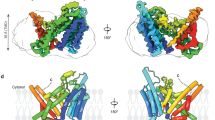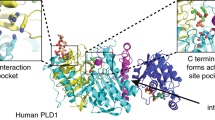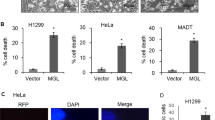Abstract
Lysophosphatidic acid (LPA) is a naturally occurring component of phospholipid and plays a critical role in the regulation of many physiological and pathophysiological processes including cell growth, survival, and pro-angiogenesis. LPA is converted to phosphatidic acid by the action of lysophosphatidic acid acyltransferase (LPAAT). Five members of the LPAAT gene family have been detected in humans to date. Here, we report the identification of a novel LPAAT member, which is designated as LPAAT-ζ. LPAAT-ζ was predicted to encode a protein consisting of 456 amino acid residues with a signal peptide sequence and the acyltransferase domain. Northern blot analysis showed that LPAAT-ζ was ubiquitously expressed in all 16 human tissues examined, with levels in the skeletal muscle, heart, and testis being relatively high and in the lung being relatively low. The human LPAAT-ζ gene consisted of 13 exons and is positioned at chromosome 8p11.21.
Similar content being viewed by others
Introduction
Lysophosphatidic acid (LPA) is the simplest form of naturally occurring phospholipids and is also known to have a growth-factor-like activity in the regulation of numerous cellular responses through the activation of specific G-protein-coupled receptors. LPA is present in several biological fluids (serum, plasma, and aqueous humor) and is produced in variety types of cells including platelets, fibroblasts, adipocytes, and cancers.
LPA production is associated with a number of diseases, such as cancer and injuries, and may be involved in the pathogenesis of cancer, obesity, and arteriosclerosis. Cellular responses regulated by LPA include mitogenesis, cell adhesion, cytoskeletal rearrangements, ion transport, cell differentiation, smooth muscle contraction, and apoptosis (Moolenaar 1995). Recently, LPA was recognized as a diagnostic marker for ovarian cancer.
Whereas LPA is well known as a lipid growth factor, it was originally considered as a membrane component and a metabolic intermediate in lipid biosynthesis. In cells, LPA is converted to phosphatidic acid (PA), a precursor in the biosynthesis of all the species of glycerolipid, by the action of lysophosphatidic acid acyltransferase (LPAAT; EC 2.3.1.51, 1-acylglycerol-3-phosphate acyltransferase; Kent 1995). PA is also involved in phospholipid signal transduction and is rapidly increased upon cellular activation and mitogenesis (Brindley and Waggoner 1996; English et al. 1996). In the membrane of the endoplasmic reticulum, the conversion rate of LPA to PA is especially high. Consistent with this phenomenon, LPAAT is more concentrated in microsomes and in the plasma membrane. Further researches have revealed that LPAAT activity may be regulated by phosphorylation in response to interleukin-1 (Soling et al. 1989; Bursten et al. 1991).
The genes coding for LPAAT have been characterized in non-mammalian and mammalian species. Bioinformatic approaches have facilitated the cloning of human genes as substantial amounts of information and resources have accumulated during the progress of the human genome project. Five human LPAAT genes have been identified to date, two of which have been fully characterized as having enzymatic activity (Eberhardt et al. 1997; Stamps et al. 1997; West et al. 1997; Aguado and Campbell 1998). In this report, we describe the identification of a novel human LPAAT gene. This study should facilitate research on LPAAT and its substrate.
Materials and methods
Sequence data mining
A BLAST (basic local alignment search tool) search of the GenBank database with the mouse LPAAT sequence (AF015811) revealed a series of human expressed sequence tags (ESTs: BE312159, BE545487, BE730936, etc) that had homology to the mouse query. These ESTs were then assembled resulting in the formation of a 2592-bp contig by the ContigExpress program in the Vector NTI software package.
Cloning and sequencing
Based on the EST contig sequence, two oligonucleotide primers (forward: 5'-GCTGGCCTGGCCTGGATCTTC-3'; reverse: 5'-GAGTCTGGAAAGGACACAGCAG-3') were synthesized in order to obtain a long open reading frame (ORF) in the assembled sequence, by using a human testis cDNA library (GibcoBRL) as a template in a polymerase chain reaction (PCR). The 1490-bp DNA fragment by PCR was then isolated from low-melting-temperature agarose and subjected to direct sequencing with a Q377 automated sequencer (ABI). The PCR product was also subcloned into a pGEM-T vector (Promega) and verified by nucleotide sequencing.
Northern blotting
Northern blots containing poly(A)-selected human RNA isolated from 16 tissues (heart, brain, placenta, lung, liver, muscle, kidney, pancreas, spleen, thymus, prostate, testis, ovary, small intestine, colon, and peripheral blood leukocytes) were purchased from CLONTECH (Palo Alto, Calif.). A DNA segment containing the LPAAT-ζ ORF was used as a probe after labeling with [32P]-dATP (Random Primers Labeling Kit, Amersham). Hybridization was carried out as previously described (Tu et al. 2000). β-Actin cDNA was used as a control.
Results
PCR cloning of LPAAT-ζ cDNA
We first searched human EST sequences in public databases for those having homology to a mouse LPAAT sequence (AF015811) and constructed a possible contig by assembling several ESTs. A 1490-bp cDNA fragment was obtained by PCR with the designed primers and cDNA as a template (see above). The fragment contained a 1368-bp ORF, which encoded a predicted protein of 456 amino acid residues with a calculated molecular mass of 52.1 kDa (Fig. 1A). This novel gene was designated as LPAAT-ζ based on its amino acid sequence homology to other members of human LPAAT family (see below).
Human LPAAT-ζ cDNA sequence and its genomic structure. A The nucleotide and putative amino acid sequences of human LPAAT-ζ. The sequences underlined are the primers used to clone the DNA segment (boxed letters poly(A) signal, asterisk stop codon). The conserved motifs of NHTSxxD and PEGTC are shown in gray. The predicted signal peptide is indicated in italics. B Top Genomic organization around LPAAT-ζ. This result was obtained after BLAST searches with the Human Genome Working Draft database (http://genome.ucsc.edu/). Triangles STS markers, arrows human LPAAT-ζ and its neighboring genes. Bottom Exon distribution of human LPAAT-ζ. C Junctions between introns and exons of LPAAT-ζ. The size and positions of exons are shown
Genomic structure around the LPAAT-ζ gene
With the determined human LPAAT-ζ cDNA sequence, we searched human genomic sequences in the Human Genome Working Draft database (http://genome.ucsc.edu/) and found that the human LPAAT-ζ gene consisted of 13 exons and 12 introns and spanned about 122 kb at chromosome 8p11.21 (Fig. 1B). All the intron-exon boundaries followed the "GT-AG" rule (Fig. 1C). The STS markers (D8S464, D8S482, and D8S392) were localized near the LPAAT-ζ gene, and the ANK1 gene (NM_000037) encoding Ankyrin 1 was situated adjacent to LPAAT-ζ (Fig. 1B).
Protein properties of LPAAT-ζ
LPAAT-ζ shared 11%–16% identical amino acid residues with the other five members of the human LPAAT family. Within the acyltransferase domain, the identity increased to the 17%-21% range (Fig. 2A). The predicted enzymatic domain of LPAAT-ζ was in the region of amino acids 234–403. In addition, LPAAT-ζ contained a predicted signal peptide sequence in the region of amino acids 1–37 (Nielsen et al 1997). The calculated pI value of the LPAAT-ζ protein was 9.28. Like other human LPAAT members, the LPAAT-ζ protein was predicted to have multiple hydrophobic regions, which may serve as transmembrane regions (Fig. 2B). Phylogenetic analysis showed that LPAAT-α and LPAAT-β had a close relationship, with LPAAT-γ and LPAAT-ε exhibiting another close relationship. LPAAT-ζ was relatively distinct among the members in the phylogenic relationship (Fig. 2C).
Amino acid sequence similarity in the enzyme domain and hydrophobic profiles among six human LPAAT members. A The amino acid alignment of the enzyme domains of the six human LPAATs was configured by the Align X program in VectorNTI Software. GenBank accession numbers are as follows: LPAAT-alpha, U56417; LPAAT-beta, U56418; LPAAT-gamma, AF156774; LPAAT-delta, AF156776; LPAAT-epsilon, AF375789; LPAAT-zeta, AF406612. Identical amino acid residues in the family are marked in black, conservative residues are given in dark gray, and similar blocks are shown in light gray. Dashes and spaces introduced to optimize the alignment, dots omitted amino acid residues outside of the domain. B Transmembrane profiles of the six LPAAT members were predicted by the TMpred program. C Phylogenic tree of six members of the human LPAAT family
Tissue expression pattern of human LPAAT-ζ
Northern blot analysis demonstrated that human LPAAT-ζ mRNA was ubiquitously expressed in all the 16 human tissues tested, but that the levels of its expression varied in respective tissues. Higher expression was detected in skeletal muscle, heart, and testis, while lower levels were found in the brain, lung, thymus, small intestine, colon, and peripheral blood leukocytes (Fig. 3). Three transcripts with 3 kb, 4.3 kb, and 4.6 kb were detected in the tissues examined, and an additional transcript of 2.7 kb was detected in the testis.
Discussion
The initial step of phospholipid biosynthesis involves the acylation of glycerol-3-phosphate (G3P) at the sn-1 position by G3P acyltransferase to form LPA. The second step involves the acylation of LPA at the sn-2 position by LPAAT to form PA. LPA and PA are two phospholipids involved in signal transduction and in lipid biosynthesis in cells. As a key enzyme in glycerophospholipid biosynthesis, LPAAT has been extensively characterized in both non-mammalian and mammalian species. We have characterized the sixth member of the human LPAAT family.
Previous sequence alignment of LPAAT proteins from various species shows that the regions around the amino acid sequences NHQSxxD and PEGTR, which occur at amino acids 103–109 and 177–181 of human LPAAT-α respectively, are the most conserved sequences (Leung 2001). Site-directed mutagenesis has shown that the conserved His and Asp residues within the motif NHQSxxD and the Glu and Gly residues within the motif PEGTR are essential for catalytic function (Lewin et al. 1999; Heath and Rock 1998). Although the identical amino acid residues do not occupy any given position among all the six members of the family, the LPAAT-ζ protein nevertheless contains sequence similarities within these two core regions. The corresponding sequences are NHTSPID and PEGTC at amino acids 247–253 and 321–325 respectively.
All six members of the human LPAAT family appear to contain a structural motif of four transmembrane regions (Fig. 2B). Although the position of the four transmembrane regions are not exactly matched among the members, and the profiles of the four transmembrane regions in LPAAT-α and β and in LPAAT-γ and ε are similar. This is consistent with the phylogenic relationship between the six human LPAAT members (Fig. 2C).
Among the five human LPAAT members reported previously, only LPAAT-α and β have been characterized with respect to enzymatic activity (West et al. 1997; Eberhardt et al. 1997; Stamps et al. 1997; Aguado and Campbell 1998). Although the other three members (LPAAT-γ, δ, and ε) have been cited in a review (Leung 2001) and deposited in public sequence databases, confirmation is lacking whether they have enzymatic activity or not. This is also the case with our LPAAT-ζ; we will report this elsewhere, after completion of characterization.
Northern blot analysis showed that LPAAT-ζ was expressed in all the 16 human tissues tested, with the highest expression level being found in skeletal muscle. Three transcripts of 3 kb, 4.3 kb, and 4.6 kb were detected in all tissues examined, a result that may attributable to the alternative utilization of polyadenylation signals at the 3'-untranslated region. The transcript with a smaller size was detected exclusively in the testis; this may be a tissue-specific splicing variant. According to previous reports (Eberhardt et al.1997, West 1997), LPAAT-α and β were also ubiquitously expressed in various human tissues. However, the relative expression level in the respective tissues varied among LPAAT-α, β and ζ. LPAAT-α was abundantly expressed in the heart, brain placenta, lung, liver, skeletal muscle, kidney, pancreas, spleen, lymph node, thymus, appendix, peripheral blood lymphocytes, and bone marrow, and was undectable in fetal liver. LPAAT-β was highly expressed in the liver, pancreas, heart, small intestine, lung, liver, and skeletal muscle, moderately expressed in the spleen, thymus, prostate, testis, ovary, colon, peripheral blood lymphocytes, and kidney, and slightly expressed in the placenta and the certain regions of the brain. Both LPAAT-α and β generated only one transcript. The different expression profiles among the LPAAT members suggest that these three genes are individually regulated and are likely to have independent functions.
References
Aguado B, Campbell RD (1998) Characterization of a human lysophosphatidic acid acyltransferase that is encoded by a gene located in the class III region of the human major histocompatibility complex. J Biol Chem 273:4096–4105
Brindley DN, Waggoner DW (1996) Phosphatidate phosphohydrolase and signal transduction. Chem Phys Lipids 80:45–57
Bursten SL, Harris WE, Bomsztyk K, Lovett D (1991) Interleukin-1 rapidly stimulates lysophosphatidate acyltransferase and phosphatidate phosphohydrolase activities in human mesangial cells. J Biol Chem 266:20732–20743
Eberhardt C, Gray PW, Tjoelker LW (1997) Human lysophosphatidic acid acyltransferase. cDNA cloning, expression, and localization to chromosome 9q34.3. J Biol Chem 272:20299–20305
English D, Cui Y, Siddiqui RA (1996) Messenger functions of phosphatidic acid. Chem Phys Lipids 80:117–132
Kent C (1995) Eukaryotic phospholipid biosynthesis. Annu Rev Biochem 64:315–343
Heath RJ, Rock CO (1998) A conserved histidine is essential for glycerolipid acyltransferase catalysis. J Bacteriol Mar 180:1425–1430
Leung DW (2001) The structure and functions of human lysophosphatidic acid acyltransferases. Front Biosci 6:D944–D953
Lewin TM, Wang P, Coleman RA (1999) Analysis of amino acid motifs diagnostic for the sn-glycerol-3-phosphate acyltransferase reaction. Biochemistry 38:5764–5771
Moolenaar WH (1995) Lysophosphatidic acid, a multifunctional phospholipid messenger. J Biol Chem 270:12949–12952
Nielsen H, Engelbrecht J, Brunak S, Heijne G von (1997) Identification of prokaryotic and eukaryotic signal peptides and prediction of their cleavage sites. Protein Eng 10:1–6
Soling HD, Fest W, Schmidt T, Esselmann H, Bachmann V (1989) Signal transmission in exocrine cells is associated with rapid activity changes of acyltransferases and diacylglycerol kinase due to reversible protein phosphorylation. J Biol Chem 264:10643–10648
Stamps AC, Elmore MA, Hill ME, Kelly K, Makda AA, Finnen MJ (1997) A human cDNA sequence with homology to non-mammalian lysophosphatidic acid acyltransferases. Biochem J 326:455–461
Tu Q, Yu L, Zhang P, Zhang M, Zhang H, Jiang J, Chen C, Zhao S (2000) Cloning, characterization and mapping of the human ATP5E gene, identification of pseudogene ATP5EP1, and definition of the ATP5E motif. Biochem J 347:17–21
West J, Tompkins CK, Balantac N, Nudelman E, Meengs B, White T, Bursten S, Coleman J, Kumar A, Singer JW, Leung DW (1997) Cloning and expression of two human lysophosphatidic acid acyltransferase cDNAs that enhance cytokine-induced signaling responses in cells. DNA Cell Biol 16:691–701
Acknowledgements
We are grateful to Dr. Dan Wu, Associate Professor, Department of Genetics and Developmental Biology, University of Connecticut Health Center, for critical reading and revision of the manuscript. The National 973 Program and 863 Project of China, National Science Fundation of China, and Med-X fund of Fudan University supported this work.
Author information
Authors and Affiliations
Corresponding author
Additional information
Electronic database information: the accession number for the data in this article is as follows: AF406612
Rights and permissions
About this article
Cite this article
Li, D., Yu, L., Wu, H. et al. Cloning and identification of the human LPAAT-zeta gene, a novel member of the lysophosphatidic acid acyltransferase family. J Hum Genet 48, 438–442 (2003). https://doi.org/10.1007/s10038-003-0045-z
Received:
Accepted:
Published:
Issue Date:
DOI: https://doi.org/10.1007/s10038-003-0045-z
Keywords
This article is cited by
-
Leu124Serfs*26, a novel AGPAT2 mutation in congenital generalized lipodystrophy with early cardiovascular complications
Diabetology & Metabolic Syndrome (2020)
-
Inter-generational instability of inserted repeats during transmission in spinocerebellar ataxia type 31
Journal of Human Genetics (2017)
-
Is hepatic lipogenesis fundamental for NAFLD/NASH? A focus on the nuclear receptor coactivator PGC-1β
Cellular and Molecular Life Sciences (2016)
-
Studies of association of AGPAT6variants with type 2 diabetes and related metabolic phenotypes in 12,068 Danes
BMC Medical Genetics (2013)
-
Clinical and genetic characterization of 16q-linked autosomal dominant spinocerebellar ataxia in South Kyushu, Japan
Journal of Human Genetics (2009)






